INSTITUT SUPERIEUR D'ANTHROPOLOGIE
INSTITUTE OF ANTHROPOLOGY
ONLINE COURSES / COURS A DISTANCE
FALL TERM : OCTOBER 2014
REGISTER NOW
TURQUIE – 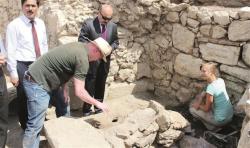 Sagalassos - A 2,000-year-old kitchen, which dates back to the late Roman era, has been discovered in the ancient city of Sagalassos in the southern province of Burdur. Excavations in the ancient city started in early June, but the discovery of the kitchen was only reported last month. “The kitchen was completely unearthed. We will learn in great detail about the kitchen culture present in that era. This is a very detailed scientific work. Not only archaeologists, but also anthropologists, zoologists and botanists are working together [on this project],” said Professor Jereon Poblome, head of excavations. “There are no tiles on the ground, only soil. The understanding of hygiene was different in the late Roman era. Ergonomically, it is a difficult kitchen for us [to use], but they became used to it. They use to put coal in the middle and a pot on it with bulgur and meat inside. They used to put two more pots on both sides to keep it warm. There were no ovens at that time, so they used a floor furnace and used it to cooked bread. All details [regarding the kitchen and its surroundings] will eventually come to light,” Poblome added, noting the ancient kitchen was very small compared to modern-day kitchens. “We are mainly working on excavating baths [at the moment]. Our works in the upper agora have been continuing for many years. We estimate that they will end in 2017-2018,” he said.Since 1990, Marc Waelkens of the Catholic University of Leuven in Belgium has been leading a major excavation project at the Sagalassos site.The first survey documents 1,000 years of occupation – from Alexander the Great to the 7th century – as well as the changing settlement patterns, vegetation history, farming practices and the changes in the climate in the area during the last 10,000 years.
Sagalassos - A 2,000-year-old kitchen, which dates back to the late Roman era, has been discovered in the ancient city of Sagalassos in the southern province of Burdur. Excavations in the ancient city started in early June, but the discovery of the kitchen was only reported last month. “The kitchen was completely unearthed. We will learn in great detail about the kitchen culture present in that era. This is a very detailed scientific work. Not only archaeologists, but also anthropologists, zoologists and botanists are working together [on this project],” said Professor Jereon Poblome, head of excavations. “There are no tiles on the ground, only soil. The understanding of hygiene was different in the late Roman era. Ergonomically, it is a difficult kitchen for us [to use], but they became used to it. They use to put coal in the middle and a pot on it with bulgur and meat inside. They used to put two more pots on both sides to keep it warm. There were no ovens at that time, so they used a floor furnace and used it to cooked bread. All details [regarding the kitchen and its surroundings] will eventually come to light,” Poblome added, noting the ancient kitchen was very small compared to modern-day kitchens. “We are mainly working on excavating baths [at the moment]. Our works in the upper agora have been continuing for many years. We estimate that they will end in 2017-2018,” he said.Since 1990, Marc Waelkens of the Catholic University of Leuven in Belgium has been leading a major excavation project at the Sagalassos site.The first survey documents 1,000 years of occupation – from Alexander the Great to the 7th century – as well as the changing settlement patterns, vegetation history, farming practices and the changes in the climate in the area during the last 10,000 years.
http://www.hurriyetdailynews.com/ancient-kitchen-found-in-sagalassos.aspx?pageID=238&nID=70745&NewsCatID=375
COREE DU SUD – 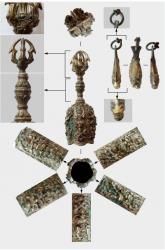 Dobong Seowon - South Korean researchers said Thursday they have uncovered dozens of artifacts used in Buddhist ceremonies nearly a millennium ago, as they begin to unravel the mystery behind an ancient shrine where they were discovered.The 77 artifacts include a vajra, a type of club with ribbed spherical heads, bells and censers thought to be from the Joseon era (1392-1910), or possibly even earlier.Researchers at the Seoul Institute of Cultural Heritage were wrapping up an archaeological field survey on Dobong Seowon, a tiny shrine for two Joseon-era scholars in northern Seoul, when they came upon a pot containing the objects.Scientists said the artifacts could even be from the earlier Goryeo Dynasty (918-1392), as the site of their discovery matches the location of a Goryeo temple ― one of the utensils even bears its name, the Dobong Temple. Joo Kyeong-mi, a professor specializing in metalcraft, said the artifacts seem to be from the 11th century “at the latest,” as some of them exhibit traits unique to those found from the eighth and ninth centuries. The fact that the pot was wrapped in a straw mat also suggests it may have been buried intentionally, she added. Although the field survey was conducted in 2012, researchers said it took them two years to ensure that the artifacts would not decompose. They were put on display at Seoul’s National Palace Museum of Korea on Thursday in an exhibit cohosted by the South Korean government. (Yonhap)
Dobong Seowon - South Korean researchers said Thursday they have uncovered dozens of artifacts used in Buddhist ceremonies nearly a millennium ago, as they begin to unravel the mystery behind an ancient shrine where they were discovered.The 77 artifacts include a vajra, a type of club with ribbed spherical heads, bells and censers thought to be from the Joseon era (1392-1910), or possibly even earlier.Researchers at the Seoul Institute of Cultural Heritage were wrapping up an archaeological field survey on Dobong Seowon, a tiny shrine for two Joseon-era scholars in northern Seoul, when they came upon a pot containing the objects.Scientists said the artifacts could even be from the earlier Goryeo Dynasty (918-1392), as the site of their discovery matches the location of a Goryeo temple ― one of the utensils even bears its name, the Dobong Temple. Joo Kyeong-mi, a professor specializing in metalcraft, said the artifacts seem to be from the 11th century “at the latest,” as some of them exhibit traits unique to those found from the eighth and ninth centuries. The fact that the pot was wrapped in a straw mat also suggests it may have been buried intentionally, she added. Although the field survey was conducted in 2012, researchers said it took them two years to ensure that the artifacts would not decompose. They were put on display at Seoul’s National Palace Museum of Korea on Thursday in an exhibit cohosted by the South Korean government. (Yonhap)
http://www.koreaherald.com/view.php?ud=20140821000846
GRECE – 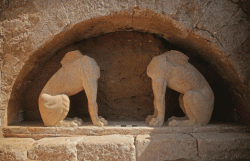
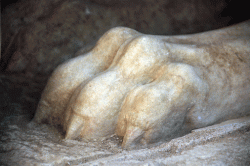 Amphipolis -Amphipolis Sphinxes are now fully revealed, as archaeologists have managed to remove 11 blocks from the “sealing” wall. Carved in marble from Thassos, the statues are 1.45m. high, while their height as a whole -with the missing heads- is thought to have been around 2.00m. Their bodies, where a thin scalpel has been used, demonstrate the delicate work of sculptors active during the last quarter of the 4th. c. BC. Parts of the Sphinxes’ wings, which were inserted in the bodies, were found during excavation, thus allowing their full reconstruction. A fragment from the back of the site’s trademark, the Amphipolis Lion, has also been found. The Sphinxes as well as the Lion seem to have been made by the same workshop. Debris removal has also revealed a small part of the monument’s superstracture, bearing traces of red and blue in two shades respectively.
Amphipolis -Amphipolis Sphinxes are now fully revealed, as archaeologists have managed to remove 11 blocks from the “sealing” wall. Carved in marble from Thassos, the statues are 1.45m. high, while their height as a whole -with the missing heads- is thought to have been around 2.00m. Their bodies, where a thin scalpel has been used, demonstrate the delicate work of sculptors active during the last quarter of the 4th. c. BC. Parts of the Sphinxes’ wings, which were inserted in the bodies, were found during excavation, thus allowing their full reconstruction. A fragment from the back of the site’s trademark, the Amphipolis Lion, has also been found. The Sphinxes as well as the Lion seem to have been made by the same workshop. Debris removal has also revealed a small part of the monument’s superstracture, bearing traces of red and blue in two shades respectively.
http://www.archaiologia.gr/en/
TURQUIE- 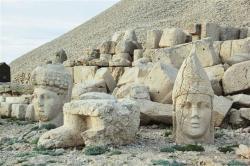 Nemrut - Huge sculptures on the world heritage site Mount Nemrut, which have been exposed to open air for more than 2,000 years, will survive with a panorama museum. Imitations of the sculptures will be made for the museum in the case they disappear someday because of climate conditions. The possible effects of corrosion caused by climate conditions have been on the agenda of the General Directorate of Cultural Heritage and Museums. Following talks with academic organizations about the preservation of these sculptures, the idea of establishing a panorama museum has arisen. The first steps have been taken for the structure. When the Adıyaman Panorama and Archaeology Museum is finished, visitors will find themselves on Mount Nemrut. The museum will be established on an area of 30,000-square meters, 10,000 of which will be a closed area. The archaeology section of the museum will display works from the early Bronze Age to the end of the Ottoman era on an area of 2,000-squaremeters.
Nemrut - Huge sculptures on the world heritage site Mount Nemrut, which have been exposed to open air for more than 2,000 years, will survive with a panorama museum. Imitations of the sculptures will be made for the museum in the case they disappear someday because of climate conditions. The possible effects of corrosion caused by climate conditions have been on the agenda of the General Directorate of Cultural Heritage and Museums. Following talks with academic organizations about the preservation of these sculptures, the idea of establishing a panorama museum has arisen. The first steps have been taken for the structure. When the Adıyaman Panorama and Archaeology Museum is finished, visitors will find themselves on Mount Nemrut. The museum will be established on an area of 30,000-square meters, 10,000 of which will be a closed area. The archaeology section of the museum will display works from the early Bronze Age to the end of the Ottoman era on an area of 2,000-squaremeters.
http://www.hurriyetdailynews.com/